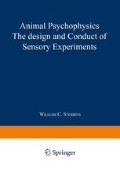Abstract
Measures of sensory acuity are obtained for varied reasons. For instance, an investigator may wish to know the effects of a drug, or a lesion, on the capacity of an animal to see, hear, or feel stimulation to which it is normally sensitive. More specifically, it is desirable to accurately assess the degree of sensory impairment resulting from some experimental treatment. Depending on the accuracy desired, the experimenter may choose an appropriate measurement technique from among a variety of procedures. No matter which technique is selected, however, the animal is always required to indicate it has detected a stimulus input by responding in some distinctive manner. Typically a cat may learn to move from one end of a box to the other when it hears a tone. Since past experience in the experimental chamber has shown the cat that failure to move during tone presentation resulted in painful electric shock, the cat usually learns to avoid shock by quickly moving across the box. Movement across the box during tone presentation is thus taken to indicate hearing. The tone may then be made progressively weaker until a signal level is reached to which the cat cannot respond, i.e., its threshold of hearing has been reached.
Access this chapter
Tax calculation will be finalised at checkout
Purchases are for personal use only
Preview
Unable to display preview. Download preview PDF.
References
Adler, H. E., and J. I. Dalland. 1959. Spectral thresholds in the starling (Sturnus vulgaris). J. Comp. Physiol. Psychol., 52:438–445.
Blough, D. S. 1956. Dark adaptation in the pigeon. J. Comp. Physiol. Psychol., 49:425–430.
Blough, D. S. 1966. The study of animal sensory processes by operant methods. In Honig, W. K., ed. Operant Behavior: Areas of Research and Application, New York, Appleton-Century-Crofts, pp. 345–379.
Clack, T. D., and P. N. Herman. 1963. A single-lever psychophysical adjustment procedure for measuring auditory thresholds in the monkey. J. Aud. Res., 3:175–183.
Dalland, J. I. 1965a. Auditory thresholds in the bat: A behavioral technique. J. Aud. Res., 5:95–108.
Dalland, J. I. 1965b. Hearing sensitivity in bats. Science, 150:1185–1186.
Dalland, J. I. J. A. Vernon, and E. A. Peterson. 1967. Hearing and cochlear microphonic potentials in the bat Eptesicus fuscus J. Neurophysiol., 30:697–709.
Dijkgraaf, S. 1946. Die Sinneswelt der Fledermäuse. Experientia, 2:438–448.
Dijkgraaf, S. 1960. Spallanzani’s unpublished experiments of the sensory basis of object perception in bats. Isis, 51, part 1, 9–20.
Elliott, D. N. 1967. Effect of peripheral lesions on acuity and discrimination in animals. In Graham, A. B., ed. Sensorineural Hearing Processes and Disorders, Boston, Little, Brown and Company, pp. 179–189.
Galambos, R. 1942. The avoidance of obstacles by flying bats. Spallanzani’s ideas (1794) and later theories. Isis, 34:132–140.
Gourevitch, G., M. H. Hack, and J. E. Hawkins. 1960. Auditory thresholds in the rat measured by an operant technique. Science, 131:1046–1047.
Griffin, D. R.1958. Listening in the Dark, New Haven, Yale University Press.
Griffin, D. R. J. J. G. McCue, and A. D. Grinnell. 1963. The resistance of bats to jamming. J. Exp. Zool., 152:229–250.
Grinnell, A. D.1963. The neurophysiology of audition in bats. J. Physiol. (London), 167:38–127.
Miller, J. D., C. S. Watson, and W. P. Covell. 1963. Deafening effects of noise on the cat. Acta Otolaryng. (Stockholm), Suppl. 176.
Vernon, J. A., J. I. Dalland, and E. G. Wever. 1966. Further studies of hearing in the bat, Myotis lucifugus, by means of cochlear potentials. J. Aud. Res., 6:153–163.
Wever, E. G. 1966. Electrical potentials of the cochlea. Physiol. Rev., 46:102–127.
Wever, E. G. and J. A. Vernon. 1961. Hearing in the bat, Myotis lucifugus, as shown by the cochlear potentials. J. Aud. Res., 1:158–175.
Author information
Authors and Affiliations
Editor information
Editors and Affiliations
Rights and permissions
Copyright information
© 1970 Springer Science+Business Media New York
About this chapter
Cite this chapter
Dalland, J.I. (1970). The Measurement of Ultrasonic Hearing. In: Stebbins, W.C. (eds) Animal Psychophysics: the design and conduct of sensory experiments. Springer, Boston, MA. https://doi.org/10.1007/978-1-4757-4514-6_2
Download citation
DOI: https://doi.org/10.1007/978-1-4757-4514-6_2
Publisher Name: Springer, Boston, MA
Print ISBN: 978-1-4757-4516-0
Online ISBN: 978-1-4757-4514-6
eBook Packages: Springer Book Archive

